Financial Accounting Report: HNBS 310 - Semester 1, 2019-20
VerifiedAdded on 2023/01/10
|24
|3969
|87
Report
AI Summary
This report presents a comprehensive analysis of financial accounting principles and practices. It begins with an introduction to financial accounting and its importance, followed by an exploration of different types of business transactions, including internal and external transactions. The report then delves into the mechanics of double-entry bookkeeping, journal entries, ledger accounts, and trial balances. It differentiates between financial reports and financial statements, outlining their respective scopes, governance, and uses. The report also examines fundamental accounting principles such as the monetary unit assumption, going concern, and the matching principle. Furthermore, it provides examples of profit and loss accounts and balance sheets. The second scenario covers bank reconciliations, explaining the process and the reasons for discrepancies. The report also describes outstanding checks, NSF, and transit cash deposits. Finally, the report concludes with a discussion of the importance of bank reconciliation and suspense accounts. This report provides a detailed overview of the core concepts and practical applications in financial accounting.

Financial accounting
Paraphrase This Document
Need a fresh take? Get an instant paraphrase of this document with our AI Paraphraser
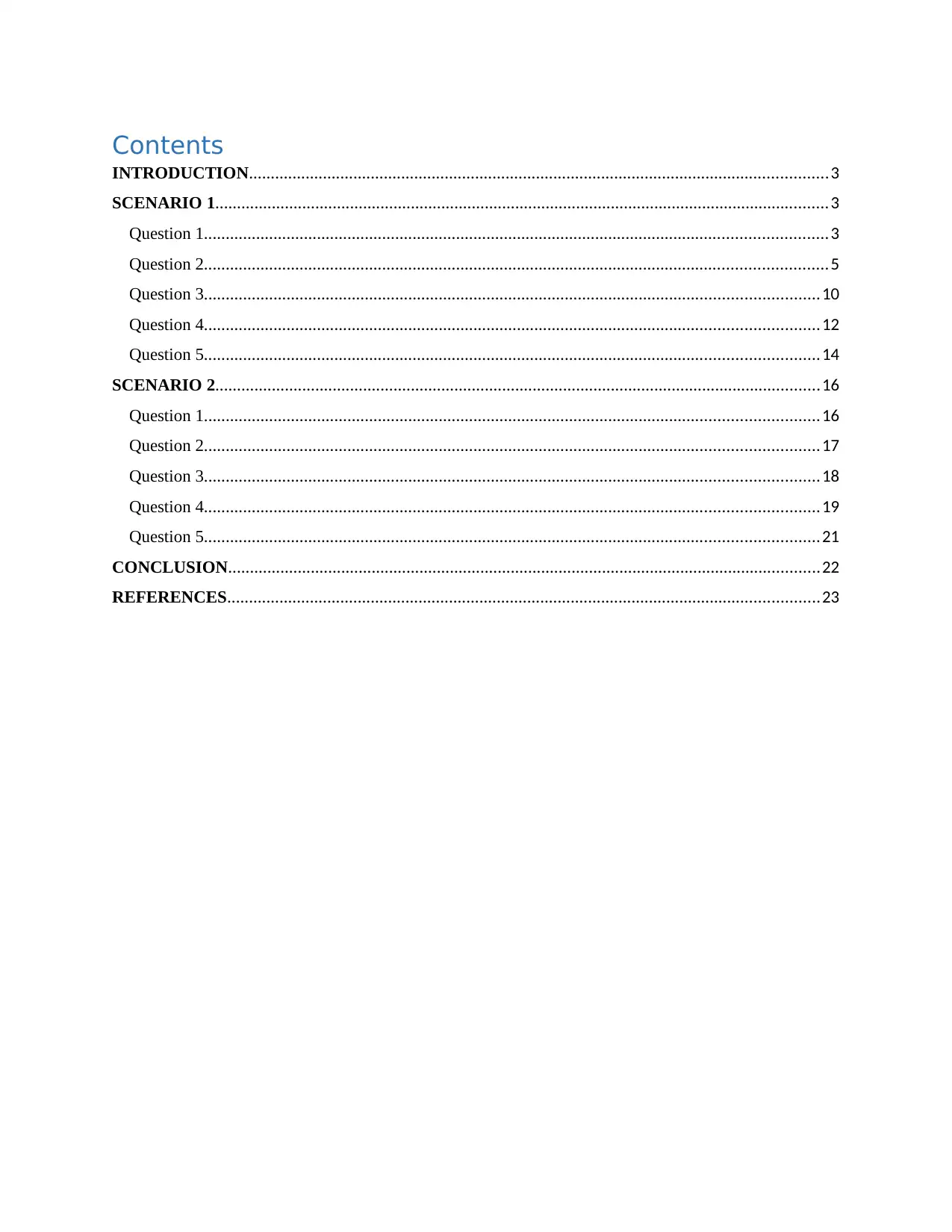
Contents
INTRODUCTION.....................................................................................................................................3
SCENARIO 1.............................................................................................................................................3
Question 1...............................................................................................................................................3
Question 2...............................................................................................................................................5
Question 3.............................................................................................................................................10
Question 4.............................................................................................................................................12
Question 5.............................................................................................................................................14
SCENARIO 2...........................................................................................................................................16
Question 1.............................................................................................................................................16
Question 2.............................................................................................................................................17
Question 3.............................................................................................................................................18
Question 4.............................................................................................................................................19
Question 5.............................................................................................................................................21
CONCLUSION........................................................................................................................................22
REFERENCES........................................................................................................................................23
INTRODUCTION.....................................................................................................................................3
SCENARIO 1.............................................................................................................................................3
Question 1...............................................................................................................................................3
Question 2...............................................................................................................................................5
Question 3.............................................................................................................................................10
Question 4.............................................................................................................................................12
Question 5.............................................................................................................................................14
SCENARIO 2...........................................................................................................................................16
Question 1.............................................................................................................................................16
Question 2.............................................................................................................................................17
Question 3.............................................................................................................................................18
Question 4.............................................................................................................................................19
Question 5.............................................................................................................................................21
CONCLUSION........................................................................................................................................22
REFERENCES........................................................................................................................................23
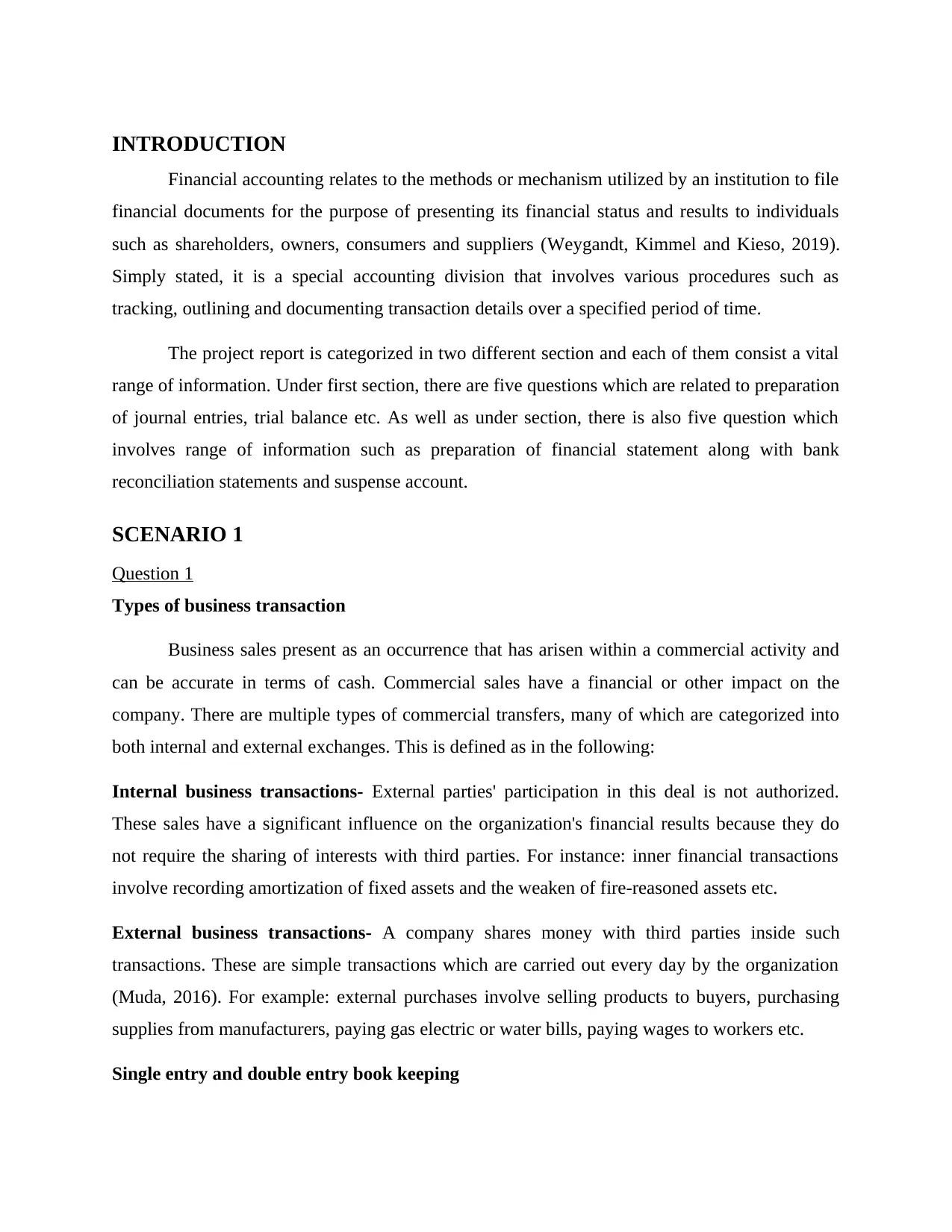
INTRODUCTION
Financial accounting relates to the methods or mechanism utilized by an institution to file
financial documents for the purpose of presenting its financial status and results to individuals
such as shareholders, owners, consumers and suppliers (Weygandt, Kimmel and Kieso, 2019).
Simply stated, it is a special accounting division that involves various procedures such as
tracking, outlining and documenting transaction details over a specified period of time.
The project report is categorized in two different section and each of them consist a vital
range of information. Under first section, there are five questions which are related to preparation
of journal entries, trial balance etc. As well as under section, there is also five question which
involves range of information such as preparation of financial statement along with bank
reconciliation statements and suspense account.
SCENARIO 1
Question 1
Types of business transaction
Business sales present as an occurrence that has arisen within a commercial activity and
can be accurate in terms of cash. Commercial sales have a financial or other impact on the
company. There are multiple types of commercial transfers, many of which are categorized into
both internal and external exchanges. This is defined as in the following:
Internal business transactions- External parties' participation in this deal is not authorized.
These sales have a significant influence on the organization's financial results because they do
not require the sharing of interests with third parties. For instance: inner financial transactions
involve recording amortization of fixed assets and the weaken of fire-reasoned assets etc.
External business transactions- A company shares money with third parties inside such
transactions. These are simple transactions which are carried out every day by the organization
(Muda, 2016). For example: external purchases involve selling products to buyers, purchasing
supplies from manufacturers, paying gas electric or water bills, paying wages to workers etc.
Single entry and double entry book keeping
Financial accounting relates to the methods or mechanism utilized by an institution to file
financial documents for the purpose of presenting its financial status and results to individuals
such as shareholders, owners, consumers and suppliers (Weygandt, Kimmel and Kieso, 2019).
Simply stated, it is a special accounting division that involves various procedures such as
tracking, outlining and documenting transaction details over a specified period of time.
The project report is categorized in two different section and each of them consist a vital
range of information. Under first section, there are five questions which are related to preparation
of journal entries, trial balance etc. As well as under section, there is also five question which
involves range of information such as preparation of financial statement along with bank
reconciliation statements and suspense account.
SCENARIO 1
Question 1
Types of business transaction
Business sales present as an occurrence that has arisen within a commercial activity and
can be accurate in terms of cash. Commercial sales have a financial or other impact on the
company. There are multiple types of commercial transfers, many of which are categorized into
both internal and external exchanges. This is defined as in the following:
Internal business transactions- External parties' participation in this deal is not authorized.
These sales have a significant influence on the organization's financial results because they do
not require the sharing of interests with third parties. For instance: inner financial transactions
involve recording amortization of fixed assets and the weaken of fire-reasoned assets etc.
External business transactions- A company shares money with third parties inside such
transactions. These are simple transactions which are carried out every day by the organization
(Muda, 2016). For example: external purchases involve selling products to buyers, purchasing
supplies from manufacturers, paying gas electric or water bills, paying wages to workers etc.
Single entry and double entry book keeping
⊘ This is a preview!⊘
Do you want full access?
Subscribe today to unlock all pages.

Trusted by 1+ million students worldwide
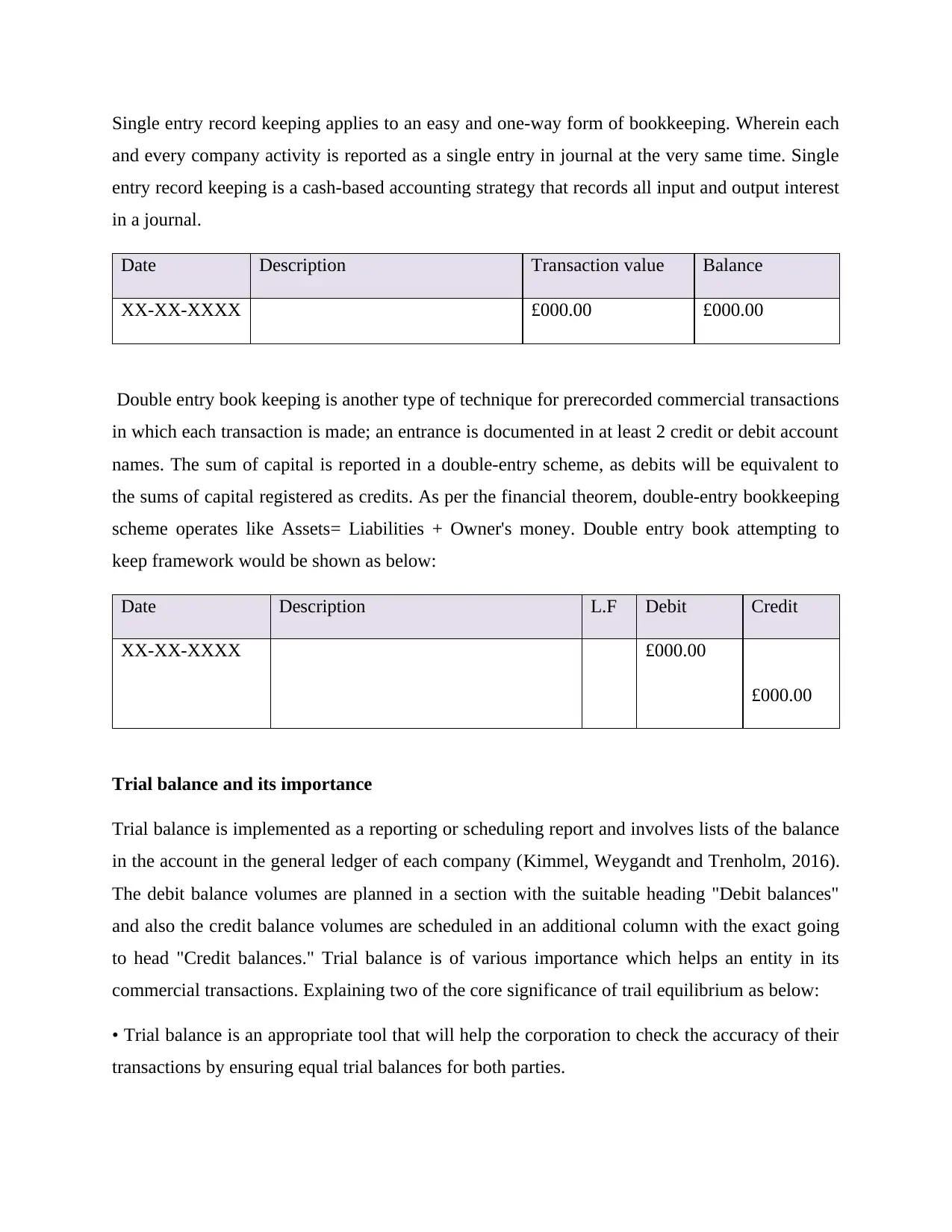
Single entry record keeping applies to an easy and one-way form of bookkeeping. Wherein each
and every company activity is reported as a single entry in journal at the very same time. Single
entry record keeping is a cash-based accounting strategy that records all input and output interest
in a journal.
Date Description Transaction value Balance
XX-XX-XXXX £000.00 £000.00
Double entry book keeping is another type of technique for prerecorded commercial transactions
in which each transaction is made; an entrance is documented in at least 2 credit or debit account
names. The sum of capital is reported in a double-entry scheme, as debits will be equivalent to
the sums of capital registered as credits. As per the financial theorem, double-entry bookkeeping
scheme operates like Assets= Liabilities + Owner's money. Double entry book attempting to
keep framework would be shown as below:
Date Description L.F Debit Credit
XX-XX-XXXX £000.00
£000.00
Trial balance and its importance
Trial balance is implemented as a reporting or scheduling report and involves lists of the balance
in the account in the general ledger of each company (Kimmel, Weygandt and Trenholm, 2016).
The debit balance volumes are planned in a section with the suitable heading "Debit balances"
and also the credit balance volumes are scheduled in an additional column with the exact going
to head "Credit balances." Trial balance is of various importance which helps an entity in its
commercial transactions. Explaining two of the core significance of trail equilibrium as below:
• Trial balance is an appropriate tool that will help the corporation to check the accuracy of their
transactions by ensuring equal trial balances for both parties.
and every company activity is reported as a single entry in journal at the very same time. Single
entry record keeping is a cash-based accounting strategy that records all input and output interest
in a journal.
Date Description Transaction value Balance
XX-XX-XXXX £000.00 £000.00
Double entry book keeping is another type of technique for prerecorded commercial transactions
in which each transaction is made; an entrance is documented in at least 2 credit or debit account
names. The sum of capital is reported in a double-entry scheme, as debits will be equivalent to
the sums of capital registered as credits. As per the financial theorem, double-entry bookkeeping
scheme operates like Assets= Liabilities + Owner's money. Double entry book attempting to
keep framework would be shown as below:
Date Description L.F Debit Credit
XX-XX-XXXX £000.00
£000.00
Trial balance and its importance
Trial balance is implemented as a reporting or scheduling report and involves lists of the balance
in the account in the general ledger of each company (Kimmel, Weygandt and Trenholm, 2016).
The debit balance volumes are planned in a section with the suitable heading "Debit balances"
and also the credit balance volumes are scheduled in an additional column with the exact going
to head "Credit balances." Trial balance is of various importance which helps an entity in its
commercial transactions. Explaining two of the core significance of trail equilibrium as below:
• Trial balance is an appropriate tool that will help the corporation to check the accuracy of their
transactions by ensuring equal trial balances for both parties.
Paraphrase This Document
Need a fresh take? Get an instant paraphrase of this document with our AI Paraphraser
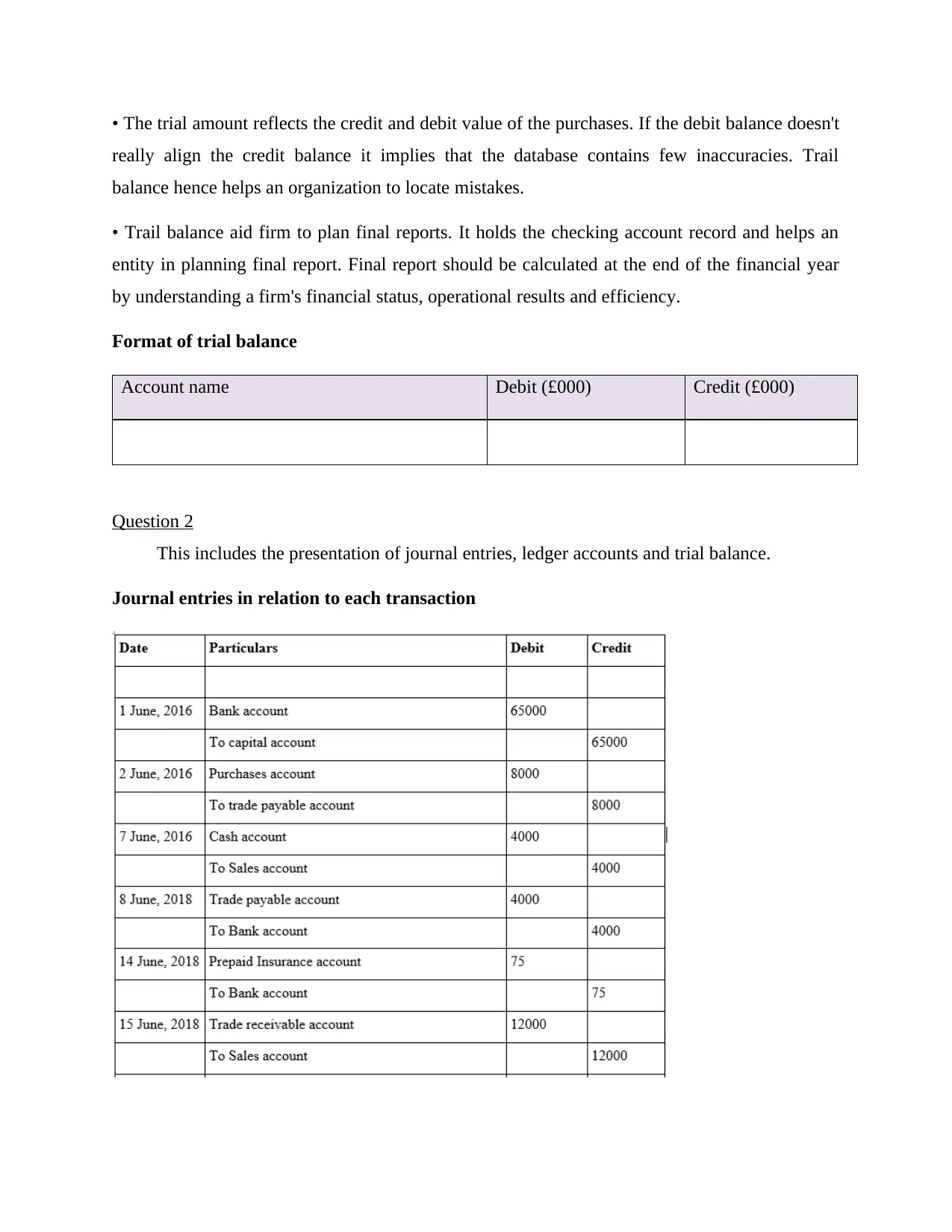
• The trial amount reflects the credit and debit value of the purchases. If the debit balance doesn't
really align the credit balance it implies that the database contains few inaccuracies. Trail
balance hence helps an organization to locate mistakes.
• Trail balance aid firm to plan final reports. It holds the checking account record and helps an
entity in planning final report. Final report should be calculated at the end of the financial year
by understanding a firm's financial status, operational results and efficiency.
Format of trial balance
Account name Debit (£000) Credit (£000)
Question 2
This includes the presentation of journal entries, ledger accounts and trial balance.
Journal entries in relation to each transaction
really align the credit balance it implies that the database contains few inaccuracies. Trail
balance hence helps an organization to locate mistakes.
• Trail balance aid firm to plan final reports. It holds the checking account record and helps an
entity in planning final report. Final report should be calculated at the end of the financial year
by understanding a firm's financial status, operational results and efficiency.
Format of trial balance
Account name Debit (£000) Credit (£000)
Question 2
This includes the presentation of journal entries, ledger accounts and trial balance.
Journal entries in relation to each transaction
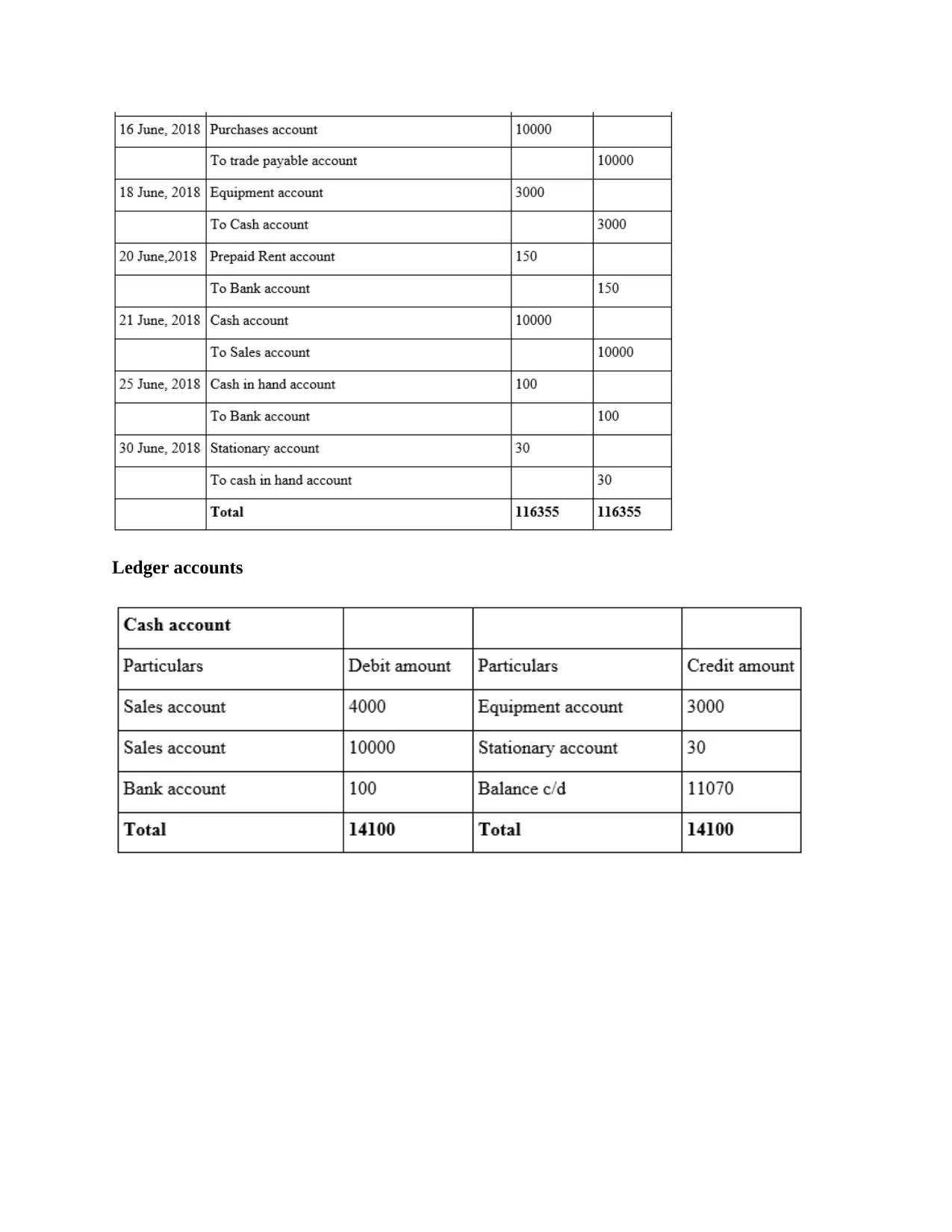
Ledger accounts
⊘ This is a preview!⊘
Do you want full access?
Subscribe today to unlock all pages.

Trusted by 1+ million students worldwide
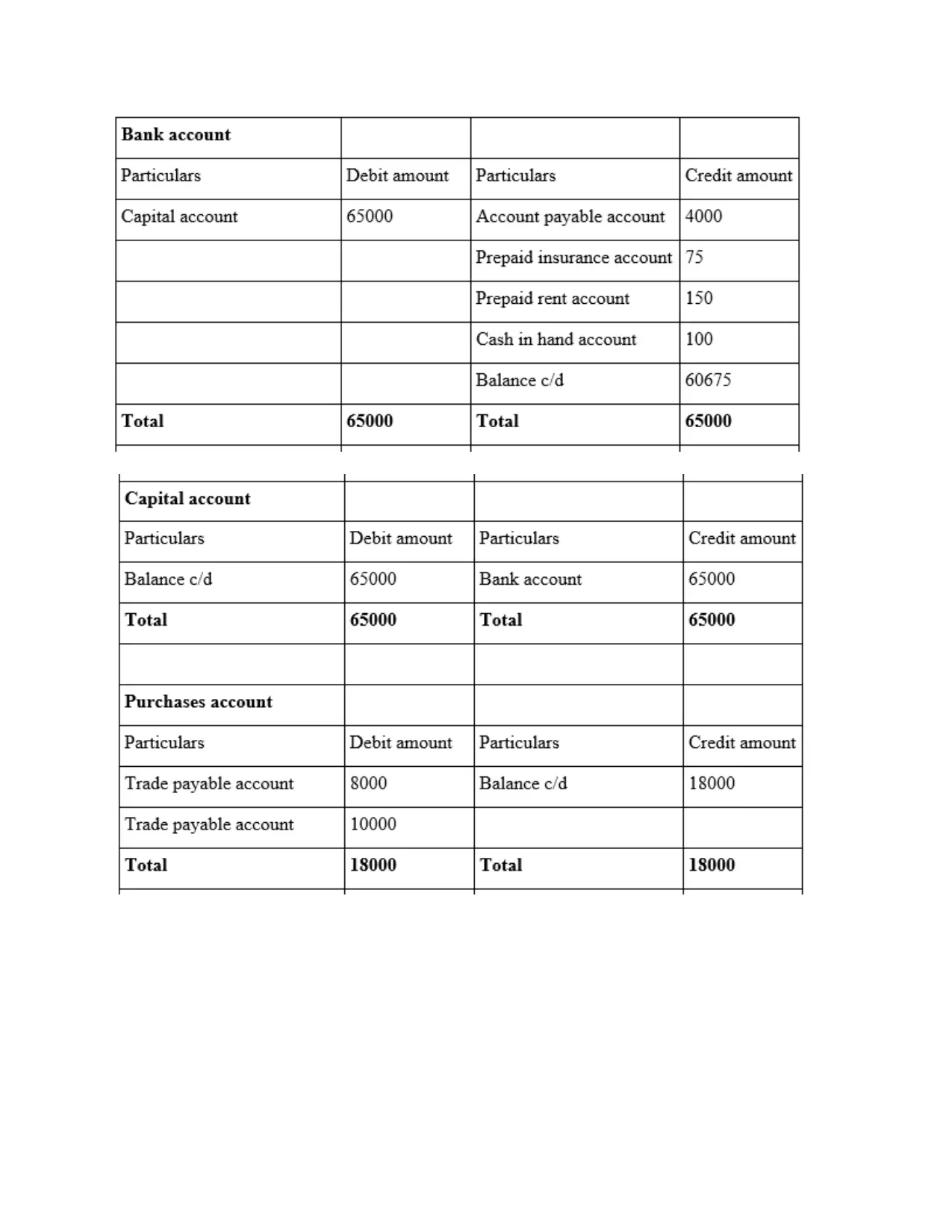
Paraphrase This Document
Need a fresh take? Get an instant paraphrase of this document with our AI Paraphraser
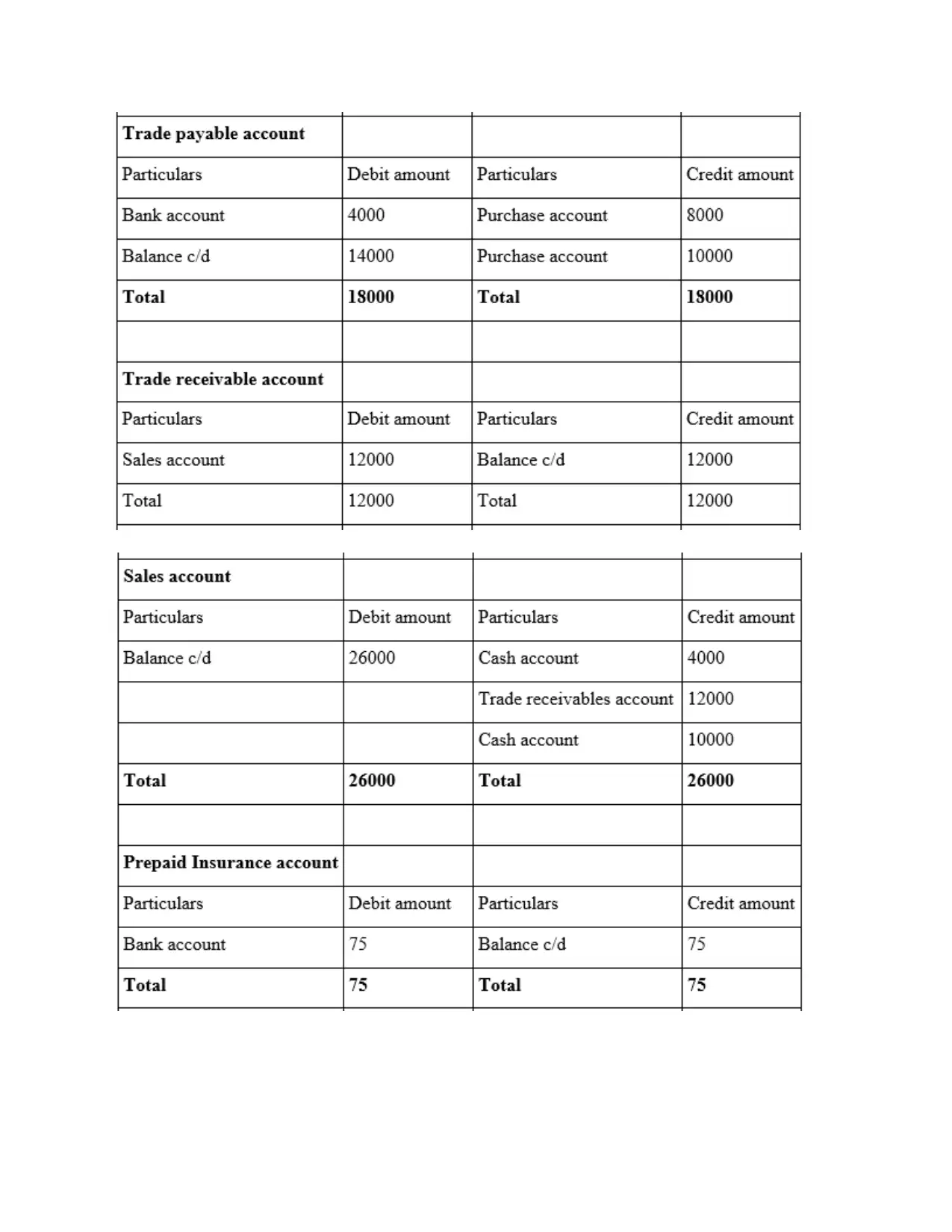
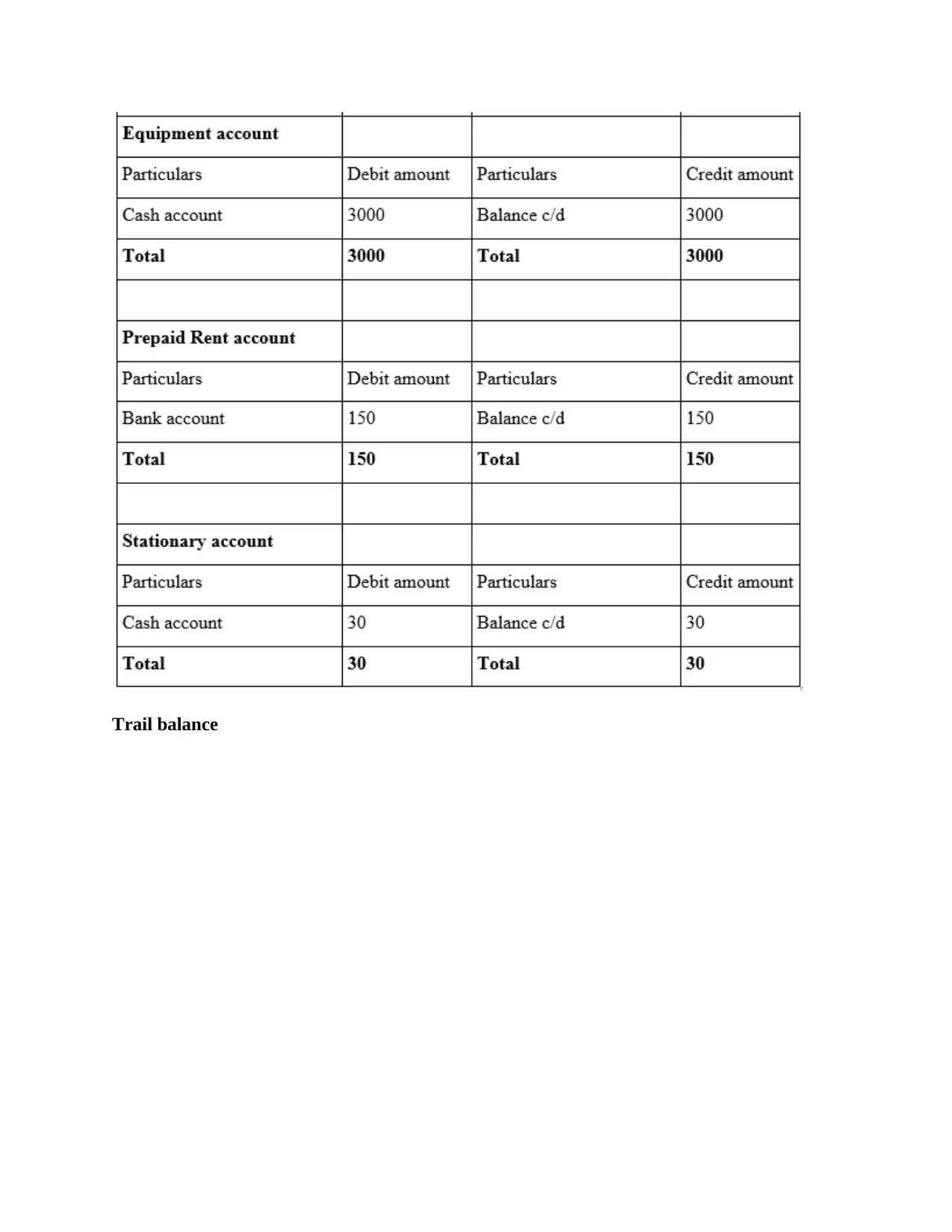
Trail balance
⊘ This is a preview!⊘
Do you want full access?
Subscribe today to unlock all pages.

Trusted by 1+ million students worldwide
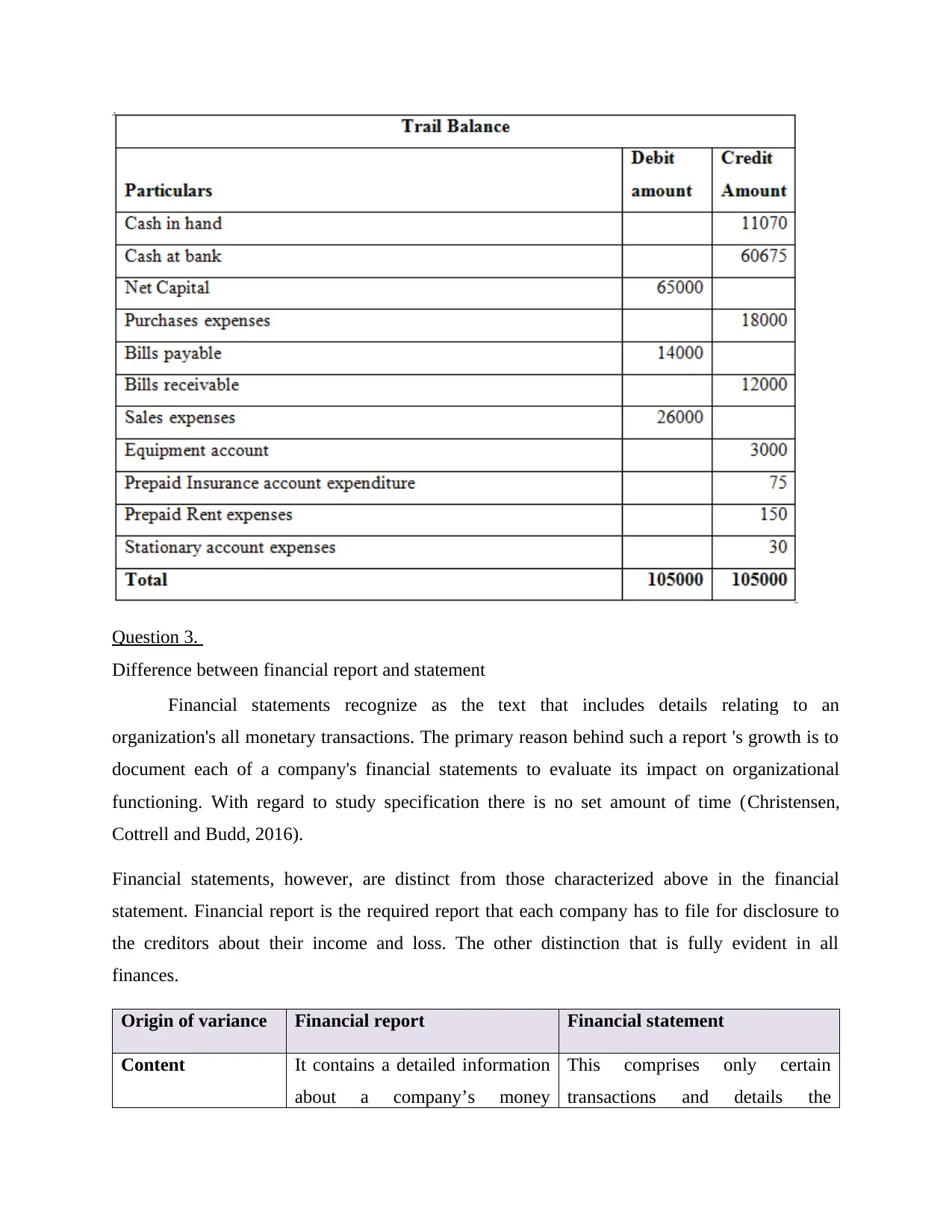
Question 3.
Difference between financial report and statement
Financial statements recognize as the text that includes details relating to an
organization's all monetary transactions. The primary reason behind such a report 's growth is to
document each of a company's financial statements to evaluate its impact on organizational
functioning. With regard to study specification there is no set amount of time (Christensen,
Cottrell and Budd, 2016).
Financial statements, however, are distinct from those characterized above in the financial
statement. Financial report is the required report that each company has to file for disclosure to
the creditors about their income and loss. The other distinction that is fully evident in all
finances.
Origin of variance Financial report Financial statement
Content It contains a detailed information
about a company’s money
This comprises only certain
transactions and details the
Difference between financial report and statement
Financial statements recognize as the text that includes details relating to an
organization's all monetary transactions. The primary reason behind such a report 's growth is to
document each of a company's financial statements to evaluate its impact on organizational
functioning. With regard to study specification there is no set amount of time (Christensen,
Cottrell and Budd, 2016).
Financial statements, however, are distinct from those characterized above in the financial
statement. Financial report is the required report that each company has to file for disclosure to
the creditors about their income and loss. The other distinction that is fully evident in all
finances.
Origin of variance Financial report Financial statement
Content It contains a detailed information
about a company’s money
This comprises only certain
transactions and details the
Paraphrase This Document
Need a fresh take? Get an instant paraphrase of this document with our AI Paraphraser
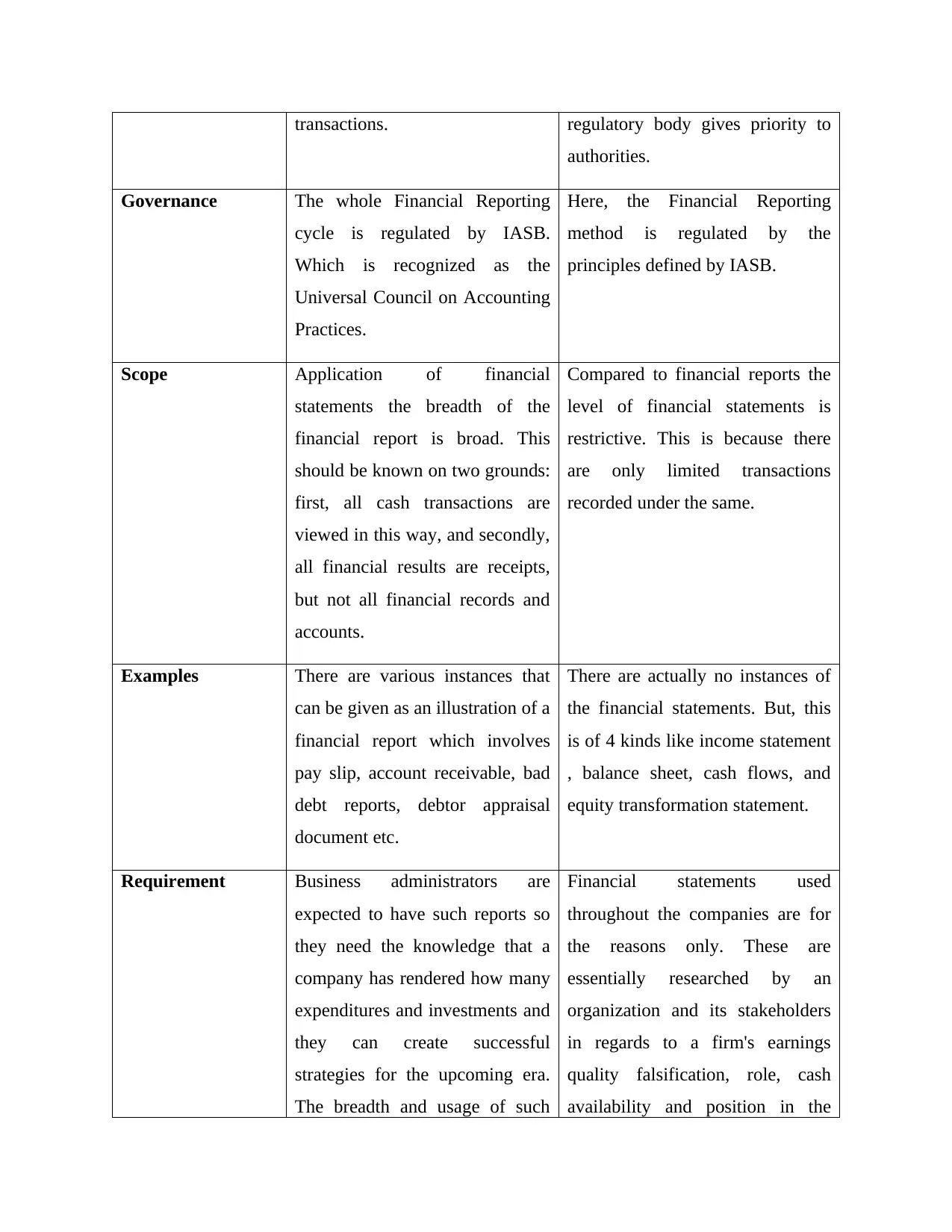
transactions. regulatory body gives priority to
authorities.
Governance The whole Financial Reporting
cycle is regulated by IASB.
Which is recognized as the
Universal Council on Accounting
Practices.
Here, the Financial Reporting
method is regulated by the
principles defined by IASB.
Scope Application of financial
statements the breadth of the
financial report is broad. This
should be known on two grounds:
first, all cash transactions are
viewed in this way, and secondly,
all financial results are receipts,
but not all financial records and
accounts.
Compared to financial reports the
level of financial statements is
restrictive. This is because there
are only limited transactions
recorded under the same.
Examples There are various instances that
can be given as an illustration of a
financial report which involves
pay slip, account receivable, bad
debt reports, debtor appraisal
document etc.
There are actually no instances of
the financial statements. But, this
is of 4 kinds like income statement
, balance sheet, cash flows, and
equity transformation statement.
Requirement Business administrators are
expected to have such reports so
they need the knowledge that a
company has rendered how many
expenditures and investments and
they can create successful
strategies for the upcoming era.
The breadth and usage of such
Financial statements used
throughout the companies are for
the reasons only. These are
essentially researched by an
organization and its stakeholders
in regards to a firm's earnings
quality falsification, role, cash
availability and position in the
authorities.
Governance The whole Financial Reporting
cycle is regulated by IASB.
Which is recognized as the
Universal Council on Accounting
Practices.
Here, the Financial Reporting
method is regulated by the
principles defined by IASB.
Scope Application of financial
statements the breadth of the
financial report is broad. This
should be known on two grounds:
first, all cash transactions are
viewed in this way, and secondly,
all financial results are receipts,
but not all financial records and
accounts.
Compared to financial reports the
level of financial statements is
restrictive. This is because there
are only limited transactions
recorded under the same.
Examples There are various instances that
can be given as an illustration of a
financial report which involves
pay slip, account receivable, bad
debt reports, debtor appraisal
document etc.
There are actually no instances of
the financial statements. But, this
is of 4 kinds like income statement
, balance sheet, cash flows, and
equity transformation statement.
Requirement Business administrators are
expected to have such reports so
they need the knowledge that a
company has rendered how many
expenditures and investments and
they can create successful
strategies for the upcoming era.
The breadth and usage of such
Financial statements used
throughout the companies are for
the reasons only. These are
essentially researched by an
organization and its stakeholders
in regards to a firm's earnings
quality falsification, role, cash
availability and position in the
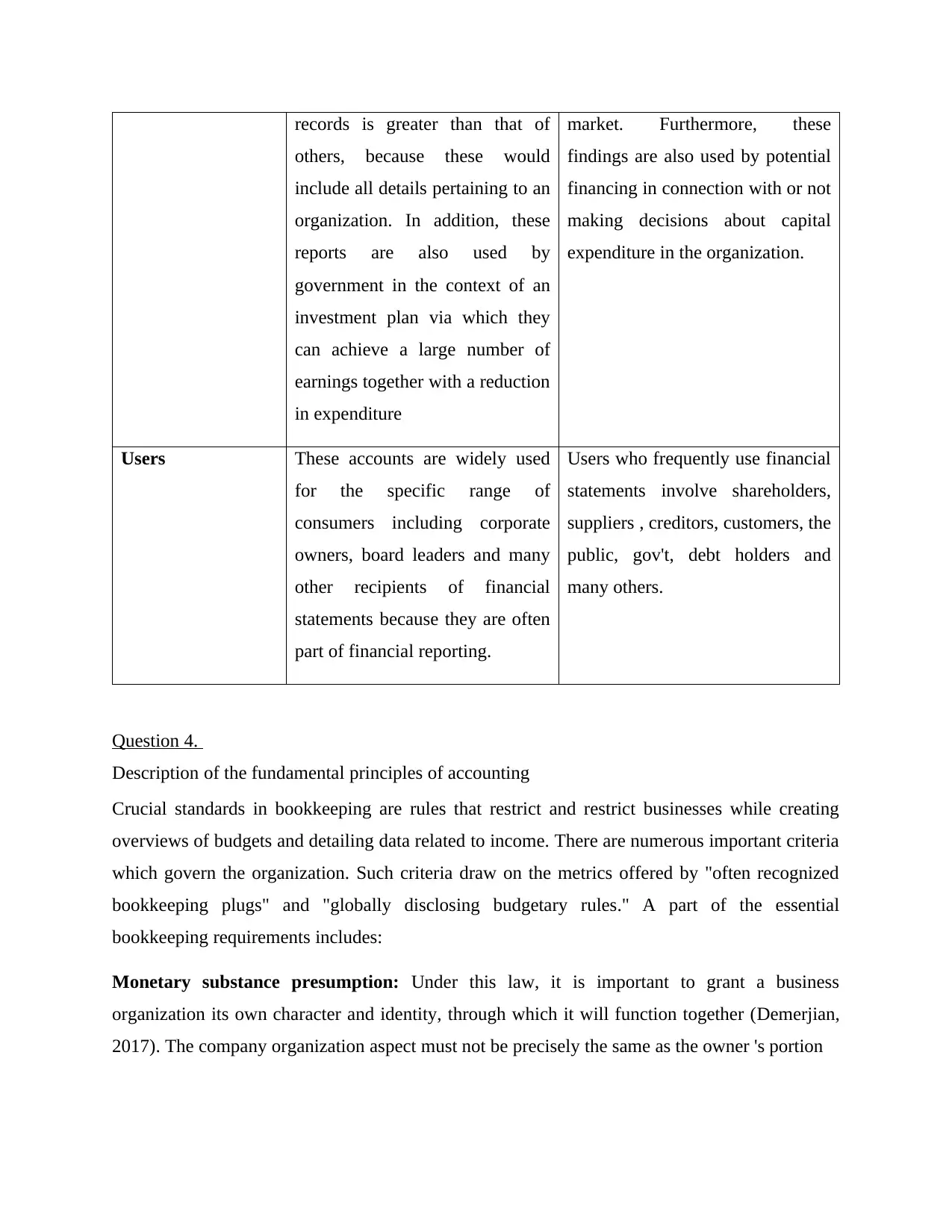
records is greater than that of
others, because these would
include all details pertaining to an
organization. In addition, these
reports are also used by
government in the context of an
investment plan via which they
can achieve a large number of
earnings together with a reduction
in expenditure
market. Furthermore, these
findings are also used by potential
financing in connection with or not
making decisions about capital
expenditure in the organization.
Users These accounts are widely used
for the specific range of
consumers including corporate
owners, board leaders and many
other recipients of financial
statements because they are often
part of financial reporting.
Users who frequently use financial
statements involve shareholders,
suppliers , creditors, customers, the
public, gov't, debt holders and
many others.
Question 4.
Description of the fundamental principles of accounting
Crucial standards in bookkeeping are rules that restrict and restrict businesses while creating
overviews of budgets and detailing data related to income. There are numerous important criteria
which govern the organization. Such criteria draw on the metrics offered by "often recognized
bookkeeping plugs" and "globally disclosing budgetary rules." A part of the essential
bookkeeping requirements includes:
Monetary substance presumption: Under this law, it is important to grant a business
organization its own character and identity, through which it will function together (Demerjian,
2017). The company organization aspect must not be precisely the same as the owner 's portion
others, because these would
include all details pertaining to an
organization. In addition, these
reports are also used by
government in the context of an
investment plan via which they
can achieve a large number of
earnings together with a reduction
in expenditure
market. Furthermore, these
findings are also used by potential
financing in connection with or not
making decisions about capital
expenditure in the organization.
Users These accounts are widely used
for the specific range of
consumers including corporate
owners, board leaders and many
other recipients of financial
statements because they are often
part of financial reporting.
Users who frequently use financial
statements involve shareholders,
suppliers , creditors, customers, the
public, gov't, debt holders and
many others.
Question 4.
Description of the fundamental principles of accounting
Crucial standards in bookkeeping are rules that restrict and restrict businesses while creating
overviews of budgets and detailing data related to income. There are numerous important criteria
which govern the organization. Such criteria draw on the metrics offered by "often recognized
bookkeeping plugs" and "globally disclosing budgetary rules." A part of the essential
bookkeeping requirements includes:
Monetary substance presumption: Under this law, it is important to grant a business
organization its own character and identity, through which it will function together (Demerjian,
2017). The company organization aspect must not be precisely the same as the owner 's portion
⊘ This is a preview!⊘
Do you want full access?
Subscribe today to unlock all pages.

Trusted by 1+ million students worldwide
1 out of 24
Related Documents
Your All-in-One AI-Powered Toolkit for Academic Success.
+13062052269
info@desklib.com
Available 24*7 on WhatsApp / Email
![[object Object]](/_next/static/media/star-bottom.7253800d.svg)
Unlock your academic potential
Copyright © 2020–2025 A2Z Services. All Rights Reserved. Developed and managed by ZUCOL.





